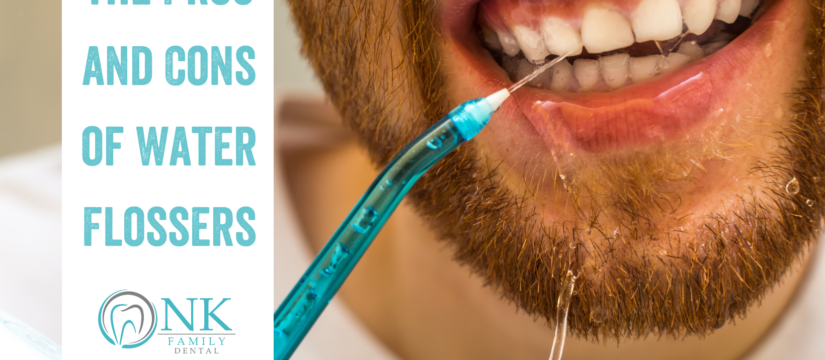
The benefits of flossing on a daily basis are well-known. As our blog post – “Is Flossing Really Necessary?” – covers, flossing is essential to maintaining optimal oral health, which also affects our overall health. But while string dental floss has been around since 1882, water flossers – also known as oral irrigation systems – provide a high-tech method of cleaning between teeth and around the gumline to help prevent cavities and periodontal disease.
Despite the increasing popularity of such devices, there are some questions about their use and effectiveness. As we always say at NK Family Dental, knowledge is power. The more you know, the better-informed your conversations with your dentist will be – and the better the outcome of treatments and preventive measures! So let’s start at the beginning!
What Is A Waterpik®?
Waterpik® is the brand name of a family of products manufactured by Water Pik, Inc. Its line of water flossers includes several models offering different options. Because the brand is the most prevalent in the marketplace, Waterpik is often erroneously used as a generic term for a water flosser or oral irrigation system. Our dental practice does not endorse any particular brand of such products but wants you to be aware that not every water flosser is a Waterpik. Therefore, for the rest of this article, we will use the term “water flosser” unless referring specifically to Waterpik.
Water flossers use a targeted, pressurized stream of pulsating water to clean away food particles, bacteria, and plaque between teeth and under the gumline. The pulsating action also beneficially stimulates the gum tissue.
How To Use A Water Flosser
While each manufacturer and each model has specific instructions, the basic operation and method of use is similar. NewMouth provides the following step-by-step guide so you can get an idea of what using a water flosser involves if you’re considering purchasing one.
- Fill the reservoir with warm water.
- Press down firmly on the device’s base.
- Choose a tip and click it into the handle.
- Start with the lowest pressure setting and then place the tip into your mouth while leaning over the sink so you don’t get water everywhere. Some people may experience a learning curve while figuring out their most comfortable water temperature and power setting.
- Turn the unit on and close your mouth just enough to prevent water splashes.
- Let the water flow from your mouth into the sink below.
- Aim the tip at your gum line.
- When complete, turn the device off and press the “eject” button to remove the tip.
For best results, start from the back of the mouth and work your way around. The process should take about two minutes. Empty water from the reservoir when finished so bacteria doesn’t grow inside.
For a boost of antibacterial effects, add salt to the water flosser to help clean out gum pockets. For maximum effectiveness, use hydrogen peroxide or vinegar to clean the machine and tips between uses. Replace the tip every three to six months.
What Are The Pros and Cons of Using A Water Flosser?
Water flossers are especially beneficial to those wearing traditional metal braces. The gentle water stream gets behind and in-between the metal wires and effectively flushes out food particles and bacteria. They are also well-suited for people with arthritis who may have difficulty wrapping string floss around their fingers and maneuvering it between teeth.
Healthline notes that a water flosser may be an attractive choice for people with non-removable bridgework, crowns, and dental implants. The pulsing water is gentle on gums so as to prevent or reduce bleeding, and gets into hard-to-reach areas, such as tightly spaced teeth and periodontal pockets caused by gum disease.
Can a water flosser replace string floss? According to Healthline, research has shown there’s very little difference in plaque removal effectiveness between a water flosser and string floss. It is worth noting that the Waterpik water flosser was the first of its kind to earn the American Dental Association’s (ADA) Seal of Acceptance for its safety and efficacy in plaque removal. The ADA provides this list of all ADA-accepted water flossers. However, many dentists believe that a water flosser alone isn’t enough to prevent cavities and periodontal disease.
“Keep in mind that water flossers are only an adjunct to brushing and flossing,” says Dr. Daniel Florian, DMD, of Royalton Dental Associates, North Royalton, OH. “If you only use water flossers and don’t floss you can still get cavities in between your teeth. You need to break the contact between your teeth with floss. I recommend hand flossing first to get the food debris out, then brushing to remove stain and plaque, and then water flossing to finish the clean.”
Other disadvantages include:
- A water flosser may not remove all plaque from the surface of the teeth.
- It costs more than string floss. However, adding the cost of string floss over the long term could make a water flosser seem like a good investment.
- It can be messy and take time to get used to. Some people may consider a water flosser too inconvenient and overall time-consuming.
The Take-Home Message
So, should you use a water flosser, string floss, or both? This is an excellent question to ask your dentist, who knows your oral health history and areas that may be vulnerable to periodontal disease, cavities or other conditions. Discussing your concerns with your dentist will eliminate the guesswork of making a decision on an oral hygiene program that may not be the best for your individual situation.
At NK Family Dental, it is our mission to provide the highest quality and most compassionate oral care to our Chicago patients, including both dental and periodontal services. Our dental specialists include our general dentist, Dr. Nilofer Khan, our endodontist, Dr. Sabek, and our periodontist, Dr. Amir Danesh.
Dr. Danesh is a board-certified periodontist and Diplomate of the American Board of Periodontology. He has contributed to the publication of two books, as well as published over 20 papers in prestigious dental research journals.
We serve the neighborhoods of Logan Square, Bucktown, Humboldt Park, and Wicker Park with the dedication that’s earned us the reputation as the Best Dentist in Chicago!
We understand that the main concern you may have is cost, which is why we accept all major PPO plans for dental insurance and also offer our in-house dental plan. Please see our financing page for more information.
Schedule your visit through ZocDoc, or contact us directly. We look forward to treating you soon!
